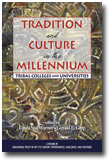
Tradition and Culture in the Millennium
Tribal Colleges and Universities
Edited by:
Linda Sue Warner, Haskell Indian National University
Gerald E. Gipp, American Indian Higher Education Consortium
A volume in the series: Educational Policy in the 21st Century: Opportunities, Challenges and Solutions. Editor(s): Bruce Anthony Jones, University of Houston.
Published 2009
This volume of The David C. Anchin Research Center Series on Educational Policy in the 21st century: Opportunities, Challenges, and Solutions focuses on tribal colleges and universities. As a recent member of higher education community, tribal colleges and universities provide a unique perspective on higher education policy. Policies and structures rely increasingly on native culture and traditions and yet provide the framework for academic rigor, collaboration, and relevance.
Tribal Colleges and Universities have played an integral role in the growing numbers of students who attain the bachelor’s degree. According to Ward (2002), these colleges and universities experienced a five-fold increase in student enrollment between 1982 and 1996. As it stands today, approximately 142,800 American Indians and Alaska Natives who are 25 and older hold a graduate or professional degree (Diverse, 2007), and Tribal Colleges and Universities have been integral to this graduate level attainment.
With this edited volume, Dr. Linda Sue Warner and Dr. Gerald E. Gipp, and the invited scholarly contributors, have provided a comprehensive explication of the phenomenal history of Tribal Colleges and Universities in the United States and the policy issues and concerns that these colleges and universities face.
CONTENTS
List of Contributors. Series Foreword, Bruce A. Jones. Introduction, Linda Sue Warner and Gerald E. Gipp. PART I: OUR HISTORY. The Story of AIHEC, David M. Gipp. Tribal Colleges and Universitites: Supporting the Revitalization in Indian Country, Wayne J. Stein. Montana Tribal Colleges, James Shanley. Growth by Degrees, Douglas Clement. The Implementation of a World Indigenous Accreditation Authority, Ray Barnhardt. PART II: CULTURE AND TRADITION. Understanding American Indian Cultures, Richard Littlebear. World View and Cultural Behaviors: Strategies and Resources Determination in the Tribal Academy, Rosemary Ackley Christensen. PART III: LEADERSHIP. Indigenous Governance, Linda Sue Warner and Kathryn Harris Tijerina. Oklahoma Tribal College Expansion: Later than Sooner Comanche Nation College, John W. Tippeconnic III. Student Retention Initiatives at Tribal Colleges and Universities and Strategies for Improvement, Robin Williams and Cornel Pewewardy. Leadership in American Indian Higher Education, Gerald E. Gipp. PART IV: OUR FUTURE. Succession of the Tribal College Presidency, Phil Baird. The Role of the Tribal College Journal in the Tribal College Movement, Marjane Ambler and Paul Boyer. Technology at the TCUs, Carrie L. Billy and Al Kuslikis. Tribal Colleges and Universities: From Where We Are to Where We Might Go, Cheryl Crazy Bull.
-
Paperback978-1-60752-000-9
Web price: $45.04 (Reg. 52.99)
-
Hardcover978-1-60752-001-6
Web price: $80.74 (Reg. 94.99)
- eBook9781607529897

- EDU015000 - EDUCATION: Higher
- EDU037000 - EDUCATION: Research
- EDU020000 - EDUCATION: Multicultural Education
-
 College Student-Athletes
Challenges, Opportunities, and Policy Implications
College Student-Athletes
Challenges, Opportunities, and Policy Implications
-
 Contemporary Uses of Technology in K-12 Physical Education
Policy, Practice, and Advocacy
Contemporary Uses of Technology in K-12 Physical Education
Policy, Practice, and Advocacy
-
 Cultural Competence in America’s Schools
Leadership, Engagement and Understanding
Cultural Competence in America’s Schools
Leadership, Engagement and Understanding
-
 Leading Schools in Challenging Times
Eye to the Future
Leading Schools in Challenging Times
Eye to the Future
-
 Resiliency Reconsidered
Policy Implications of the Resiliency Movement
Resiliency Reconsidered
Policy Implications of the Resiliency Movement
-
 Staff Governance and Institutional Policy Formation
Staff Governance and Institutional Policy Formation
-
 Training Higher Education Policy Makers and Leaders
A Graduate Program Perspective
Training Higher Education Policy Makers and Leaders
A Graduate Program Perspective

